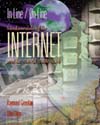 |  Inline/Online: Fundamentals of the Internet and the World Wide Web, 2/e Raymond Greenlaw,
Armstrong Atlantic State University
Ellen Hepp,
The University of New Hampshire
Advanced HTML
Chapter 9 Key TermsThis glossary contains a list of important terms used in the text. Both the terms and their meanings are presented. This list is not intended to be exhaustive. For example, many of the HTML concepts are not included, but can easily be traced through the index.
| Cascading Style Sheets | A method of specifying content that is common to a series of Web pages.
(See 120, 417, 610, 633)
|  |  |  | | CGI script | See script.
(See 389, 401-403, 516, 518-520, 610, 634)
|  |  |  | | client pull | A model of a dynamic document in which the browser (or client) initiates the document’s change. This can be used to cause a
document to “refresh” itself or to load a completely new document,
among other things.
(See 403-405, 633)
|  |  |  | | Common Gateway Interface (CGI) | A set of rules that specify how parameters are passed from programs to Web servers.
(See 389, 401-403, 516, 518-520, 610, 634)
|  |  |  | | Doctor HTML | A popular HTML syntax checker.
(See 412, 413, 415, 635)
|  |  |  | | document area | The part of the browser window that is used to display
the currently loaded document.
(See 45, 639)
|  |  |  | | dynamic document | A document that has the capacity to change, either by client pull, server push, or some other mechanism.
(See 403-407, 635)
|  |  |  | | eXtensible Markup Language (XML) | A Web page design language that will support user-defined tags.
(See 203, 417, 613, 636)
|  |  |  | | HTML converter | A program that takes one type of document as input and produces the same information in an HTML format.
(See 415-416, 638)
|  |  |  | | HTML editor | A software editing tool that helps in developing HTML code.
(See 407-412, 638)
|  |  |  | | Netscape | The Netscape Communications Company’s Web browser.
(See 412, 417, 642)
|  |  |  | | plaintext | A message in its original form; that is, not encoded.
(See 40, 415, 643)
|  |  |  | | recursive algorithm | An algorithm that calls itself.
(See 382, 644)
|  |  |  | | script or CGI script | Any program that is run by a Web server in response to a user’s request.
(See 389, 401-403, 516, 519-520, 610, 634)
|  |  |  | | server push | A model of a dynamic document in which the server initiates the document’s change. Server push is not accomplished using HTML tags.
(See 405, 646)
|  |  |  | | thumbnail sketch | A reduced-size image that is used to give a reader a preview of an image, so they can decide whether or not they would like to spend the time loading the full image.
(See 95, 359-360, 648)
|  |  |  | | World Wide Web Consortium (W3C) | A group that provides an open forum to facilitate communication between individuals dealing with matters related to the World Wide Web.
(See 119-121, 417, 613, 651)
|
|



 2002 McGraw-Hill Higher Education
2002 McGraw-Hill Higher Education